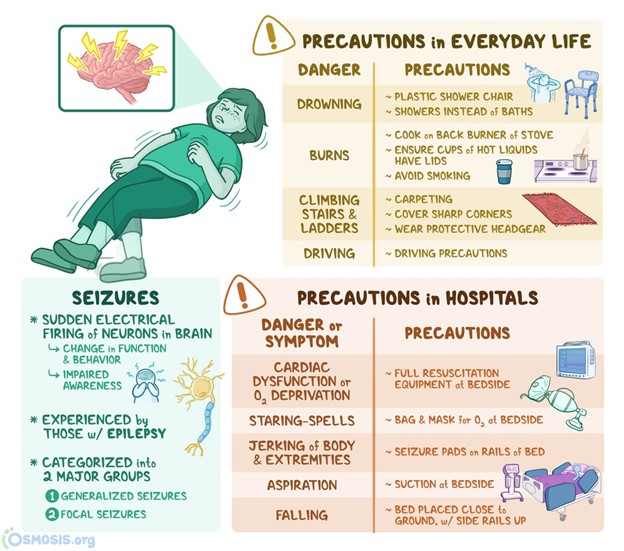A nurse is caring for an adolescent who has hyperthermia.
Which of the following actions should the nurse take?
Cover the adolescent with a thermal blanket
Submerge the adolescent’s feet in ice water
Initiate seizure precautions
Administer oral acetaminophen
The Correct Answer is C

Hyperthermia is a condition in which the body temperature is abnormally high, usually due to exposure to heat, infection, or certain medications.
Hyperthermia can cause neurological complications, such as seizures, confusion, or coma. Therefore, the nurse should initiate seizure precautions for an adolescent who has hyperthermia to prevent injury and protect the airway.
Choice A is wrong because covering the adolescent with a thermal blanket would increase the body temperature and worsen hyperthermia. The nurse should remove excess clothing and use cooling measures, such as fans, ice packs, or cool fluids.
Choice B is wrong because submerging the adolescent’s feet in ice water would cause vasoconstriction and shivering, which would reduce heat loss and increase heat production. The nurse should avoid using extreme cold or ice water to cool the body.
Choice D is wrong because administering oral acetaminophen would not be effective for hyperthermia caused by non-infectious factors, such as heat exposure or medications.
Acetaminophen lowers the body temperature by reducing the hypothalamic set point, which is not altered in hyperthermia. Additionally, oral medications may be difficult to swallow or absorb in a hyperthermic patient.
Normal body temperature ranges from 36.5°C to 37.5°C (97.7°F to 99.5°F). Hyperthermia is defined as a body temperature above 38.5°C (101.3°F).
Nursing Test Bank
Naxlex Comprehensive Predictor Exams
Related Questions
Correct Answer is D
Explanation
The correct answer is choice D. Shuffling gait. This is because shuffling gait is a common manifestation of pseudoparkinsonism, which is a condition that mimics the symptoms of Parkinson’s disease due to the use of certain medications that block dopamine receptors, such as haloperidol. Pseudoparkinsonism can cause slowed movements, muscle stiffness, tremor, and postural instability.
Choice A. Nonreactive pupils is wrong because this is not a typical feature of pseudoparkinsonism or Parkinson’s disease.
Nonreactive pupils can be caused by other conditions, such as brain injury, drugs, or eye diseases.
Choice B. Serpentine limb movement is wrong because this is a characteristic of tardive dyskinesia, another drug-induced movement disorder that can result from long-term use of dopamine receptor blocking agents. Tardive dyskinesia causes involuntary movements of the face, tongue, and limbs that are often writhing or twisting.
Choice C. Smacking lips is wrong because this is also a sign of tardive dyskinesia, not pseudoparkinsonism. Smacking lips is one of the orofacial movements that can occur in tardive dyskinesia due to abnormal muscle contractions.
Correct Answer is A
Explanation
The correct answer is choice A. The nurse should ensure the state health department has been notified of the child’s Lyme disease, as it is a reportable disease in most states.
Reporting helps to monitor the incidence and prevalence of Lyme disease and to implement prevention and control measures.
Choice B is wrong because antitoxin is not used to treat Lyme disease.
Antitoxin is a substance that neutralizes the effects of a toxin, such as botulism or tetanus. Lyme disease is caused by a bacterium called Borrelia burgdorferi, which can be treated with antibiotics.
Choice C is wrong because Lyme disease is not transmitted by sharing personal belongings. Lyme disease is spread to humans by the bite of infected ticks that carry the
bacterium. The risk of getting Lyme disease can be reduced by avoiding tick-infested areas, wearing protective clothing, using insect repellent, and removing ticks promptly.
Choice D is wrong because skin necrosis is not a common complication of Lyme disease.
Skin necrosis is the death of skin tissue due to lack of blood supply or infection. Lyme disease can cause a characteristic skin rash called erythema migrans, which is usually circular or oval and expands over time. Other possible signs and symptoms of Lyme disease include fever, headache, fatigue, joint pain, and neurological problems.
Whether you are a student looking to ace your exams or a practicing nurse seeking to enhance your expertise , our nursing education contents will empower you with the confidence and competence to make a difference in the lives of patients and become a respected leader in the healthcare field.
Visit Naxlex, invest in your future and unlock endless possibilities with our unparalleled nursing education contents today
Report Wrong Answer on the Current Question
Do you disagree with the answer? If yes, what is your expected answer? Explain.
Kindly be descriptive with the issue you are facing.
